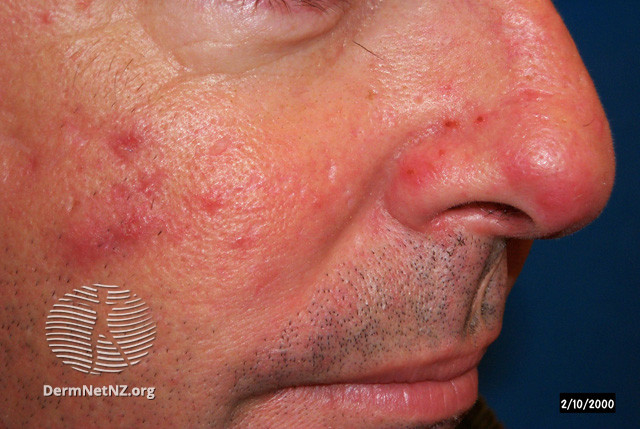Rosacea
Rosacea is a chronic, relapsing disorder with intermittent or persistent facial flushing, telangiectasia, papules and pustules, in the absence of comedones. The rash usually involves forehead, cheeks & chin, sparing the peri-orbital & peri-oral areas. Not all signs may be present in the same patient.
It is more common in fair skinned people and peak incidence is 40-50 years.
Rosacea can also cause ocular symptoms in > 50% of patients and can cause dry gritty eyes, conjunctivitis, blepharitis, episcleritis & chalazion. Keratitis may be a more serious complication.
Rhinophyma


Less commonly, rosacea can develop Rhinophyma where the shape and size of the nose changes
All images on this page are sourced from DermNet | Dermatology Resource (dermnetnz.org)
R.C 24-05-24
Referral Guidelines
- Severe unresponsive disease for consideration of isotretinoin
- Refer to Plastic Surgery for consideration of laser or surgical therapy:
- Rhinophyma
- Severe Telangiectaisa
- Refer to Ophthalmology for associated keratitis.
Management
General Advice
- Give patient information sheet
- Advise about oil-free products
- Advise on UV protection
- Cosmetic camouflage may be helpful for flushing, erythema and telanglectasia which will not respond to topical or oral antibiotics
- Avoid exacerbating factors: spicy foods, alcohol, hot drinks, caffeine, temperature changes, sun exposure
- Avoid topical steroids where possible
Topical Therapy
For mild to moderate rosacea.
- Use topical agents for 2-3 months then intermittently as required
- Metronidazole gel or cream od
- Azelaic acid 15% gel or 20% cream od
- Ivermectin cream 10mg/g od
- Brimonidine 0.33% gel for temporary improvement of erythema as required od
Systemic therapy
For mild to moderate rosacea.
- 2-3 months courses required intermittently
- Lymecycline 408mg od
- Doxycycline 100mg od
- Erythromycin 500mg bd
Therapeutic Tips
- If no improvement after 3 months switch to alternative antibiotic
- Intermittent or continuous antibiotics may be required if recurrent flares and there is scope to use low dose antibiotics in the longer term once symptoms have settled (e.g. doxycycline 50-100mg daily)
Management of Ocular Symptoms
- Lid hygiene – clean the eyelids using cotton wool soaked in cooled, boiled water
- Artificial tears – should be applied liberally throughout the day. If necessary a lubricating ointment, sometimes containing an antibiotic preparation may be used at night
- Systemic tetracyclines are the most effective treatment for ocular rosacea. Erythromycin can be taken orally for patients intolerant of tetracyclines
- Retinoids should be avoided in patients with significant ocular problems as they can worsen symptoms and lead to a severe keratitis
- Troublesome ocular symptoms that persist despite of treatment should be referred to an ophthalmologist. Patients with potentially more serious symptoms such as keratitis should be referred for urgent specialist assessment.














